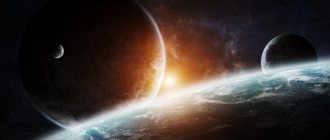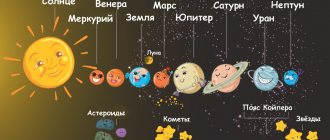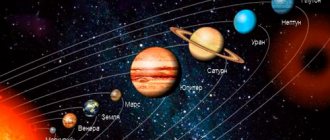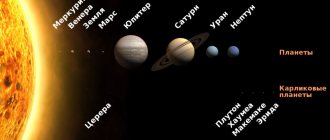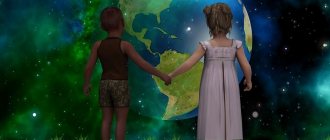Astronomy for children > Solar system
Description of the planets of the Solar System for children: consider the model of the Solar System and all the planets in order with photos and drawings, interesting facts about the Sun.
The solar system is a huge place with a lot of empty space between the planets. But there are also asteroids, comets, rocky and icy objects, and dwarf planets in the Kuiper Belt and Oort Cloud that have yet to be explored.
For the little ones , you need to know that the Solar System is represented by the Sun and the objects revolving around it: planets, asteroids, meteorites, comets and satellites. All of them extend from the main star (the ancient Romans called it "Sol") and pass the four inner planets through the Asteroid Belt to the four gas giants, the Kuiper Belt (disc-shaped) and beyond the giant Oort Cloud (spherical shape) and the teardrop heliopause . Researchers believe that the edge of the system is 15 billion km from the star.
This article will reveal the most interesting facts about the Solar System for children and provide a complete description of all planets and objects with photos, drawings, pictures and videos. In addition, you will find out which planet is the largest or smallest, the first and the last, hot and cold. Be sure to consider the diagram with the location and orbits, where all the planets of the Solar System are in full view.
What and when to tell children about space and planets?
Children after four years old listen with great interest about space, the Sun, planets, stars, and galaxies. Many children of different ages are fascinated by the starry night sky; for them it is something magical and a completely incomprehensible phenomenon. One has only to remember oneself in childhood, many dreamed of becoming cosmonauts or astronauts, flying into space or finding alien life. Some children become interested later than four years old; already in elementary school they begin to be interested in space. According to teachers, children under 3 years of age are rarely interested in space.
If parents see an interest in the unknown world in their child, they should not limit their children’s knowledge. Even children can be given their first knowledge of astronomy. In this case, the age of the child should be taken into account in order to present simple but understandable information to the child. This is the only way a child will be able to understand and remember the planets, their characteristics, and other terms related to astronomy.
Important: When telling children about the planets of the solar system, reinforce the words with visual images, videos, cartoons about space. This way, children will be able to quickly memorize the planets.
What to tell children about space:
- About the Sun and the Solar System;
- Names of planets;
- About the location of the planets from the Sun;
- Tell us a little about the planets;
- Brief information about how the planets came into being.
If the child is interested, you can develop his knowledge in the field of astronomy and tell:
- What are planetary satellites;
- What are stars, constellations;
- Name and show the most famous constellations;
- Talk about the polar star.
You should not overload your child with information, complex terms, and most importantly, you should not force your child to learn names if he does not enjoy this activity. Perhaps until the child is ready for new knowledge, it is worth waiting a little.
Planets
Terrestrial planets
Mercury
The smallest planet in the solar system has a radius of only 2440 km. The period of revolution around the Sun, equated to an earthly year for ease of understanding, is 88 days, while Mercury manages to rotate around its own axis only one and a half times. Thus, his day lasts approximately 59 Earth days. For a long time it was believed that this planet always turned the same side to the Sun, since periods of its visibility from Earth were repeated with a frequency approximately equal to four Mercury days. This misconception was dispelled with the advent of the ability to use radar research and conduct continuous observations using space stations. The orbit of Mercury is one of the most unstable; not only the speed of movement and its distance from the Sun change, but also the position itself. Anyone interested can observe this effect.
Mercury in color, image from the MESSENGER spacecraft
Its proximity to the Sun is the reason why Mercury is subject to the largest temperature changes among the planets in our system. The average daytime temperature is about 350 degrees Celsius, and the nighttime temperature is -170 °C. Sodium, oxygen, helium, potassium, hydrogen and argon were detected in the atmosphere. There is a theory that it was previously a satellite of Venus, but so far this remains unproven. It does not have its own satellites.
Venus
The second planet from the Sun, the atmosphere is almost entirely composed of carbon dioxide. It is often called the Morning Star and the Evening Star, because it is the first of the stars to become visible after sunset, just as before dawn it continues to be visible even when all the other stars have disappeared from view. The percentage of carbon dioxide in the atmosphere is 96%, there is relatively little nitrogen in it - almost 4%, and water vapor and oxygen are present in very small quantities.
Venus in the UV spectrum
Such an atmosphere creates a greenhouse effect; the temperature on the surface is even higher than that of Mercury and reaches 475 °C. Considered the slowest, a Venusian day lasts 243 Earth days, which is almost equal to a year on Venus - 225 Earth days. Many call it Earth's sister because of its mass and radius, the values of which are very close to those of Earth. The radius of Venus is 6052 km (0.85% of Earth's). Like Mercury, there are no satellites.
Earth
The third planet from the Sun and the only one in our system where there is liquid water on the surface, without which life on the planet could not have developed. At least life as we know it. The radius of the Earth is 6371 km and, unlike other celestial bodies in our system, more than 70% of its surface is covered with water. The rest of the space is occupied by continents. Another feature of the Earth is the tectonic plates hidden under the planet's mantle. At the same time, they are able to move, albeit at a very low speed, which over time causes changes in the landscape. The speed of the planet moving along it is 29-30 km/sec.
Our planet from space
One revolution around its axis takes almost 24 hours, and a complete passage through the orbit lasts 365 days, which is much longer in comparison with its closest neighboring planets. The Earth's day and year are also accepted as a standard, but this is done only for the convenience of perceiving time periods on other planets. The Earth has one natural satellite - the Moon.
Mars
Mars as seen by the Hubble Space Telescope in 2003
The fourth planet from the Sun, known for its thin atmosphere. Since 1960, Mars has been actively explored by scientists from several countries, including the USSR and the USA. Not all exploration programs have been successful, but water found at some sites suggests that primitive life exists on Mars, or existed in the past.
The brightness of this planet allows it to be seen from Earth without any instruments. Moreover, once every 15-17 years, during the Confrontation, it becomes the brightest object in the sky, eclipsing even Jupiter and Venus.
The radius is almost half that of Earth and is 3390 km, but the year is much longer - 687 days. He has 2 satellites - Phobos and Deimos .
Planets of the Solar System: names, features, history of occurrence
A good place to start telling children about space is the concept of the solar system.
The Sun is a very large star that is located at the very center of the Solar System. The sun emits heat and light, and without it life on our planet is impossible. We see and consider the Sun to be yellow, but it turns out that this star is white.
All cosmic bodies, including planets, revolve around the Sun. It is interesting that all cosmic bodies follow a certain trajectory, along their own path.
Let's find out what planets exist and what they are called.
Mercury
Of all the planets, Mercury is the smallest. But it revolves quickly around the Sun. Since the planet is located closest to the Sun, the temperature here is very high. It is noteworthy that at night the temperature on Mercury is extremely low.
Venus
The surface of this planet is represented by a hot rocky desert. Observing Venus is difficult because it is shrouded in dense clouds.
Earth
So far, Earth is the only planet on which there is life. But scientists are constantly conducting research in this area. We are inhabitants of planet Earth. The satellite of planet Earth is the Moon.
Mars
Mars is named after the Roman god of war. Sometimes you can hear that Mars is called the Red Planet. This is due to the color of its surface. The entire surface of Mars is covered with volcanoes, craters, valleys, and deserts. Mars has the highest mountains and also the deepest canyons in the entire solar system. Scientists assumed that there was once life on Mars, since there are ice caps on the surface of the planet that were once water. Mars has two satellites.
Jupiter
A giant planet that is 300 times more massive than Earth. The surface of Jupiter is gaseous; the planet does not have a solid surface. Jupiter rotates very quickly around the Sun. A day on Jupiter lasts only 12 hours. Jupiter has many satellites, 69 in total.
Saturn
Saturn is notable for its rings, consisting of dust, rocks, and ice. The surface of Saturn, like Jupiter, consists of a gaseous surface. It is known that the planet has 62 satellites.
Uranus
Uranus also has rings, but they are difficult to observe because they appear at specific times. Uranus is one of the “ice giants”. The surface of this planet has a terribly low temperature (-224°C). This is the coldest planet in the solar system. The planet's distance from the Sun does not allow the rays to heat the surface. Uranus has a lot of ice clouds. Uranus rotates around the Sun in an interesting position: its axis is shifted, the planet seems to lie on its side.
Neptune
It is located at the greatest distance from the Sun. Neptune was discovered not by observation, but by mathematical calculations. Its surface is blue, which makes Neptune especially beautiful and attractive. Strong winds rage on the planet, the strongest in the solar system.
Important: There is one more planet - Pluto. Until 2006, this planet was 9th in the list of planets. However, it was transferred to the category of dwarf planets.
Explanation of planets to children
History of the origin of planets
About 5 billion years ago there was no Sun or planets at all. But then, from the boundless cloud of gas and dust, it began to compress, forming a large core. This is how the Sun was formed. And cosmic dust and gas began to revolve around the Sun, merging into a single whole. So these clusters became planets. At first the planets were as hot as the Sun. But then the lava cooled and hardened.
Methods of representing space
Not every preschooler is able to understand what black holes are, what celestial bodies are made of, and what properties they have.
In order to explain, it is necessary to develop tactics. Firstly, the information must be truthful. Secondly, you cannot speak in serious language or use special terms. Otherwise, the child will quickly lose interest in the subject and will not want to continue a conversation he does not understand.
There are methods by which you can popularly teach children about the planets. Experience suggests that children are interested in conversation, supported by the display of pictures. You can use photographs of the starry sky, images of planets, constellations. It’s very good when dad draws the sun and talks about it. Moreover, the luminary should be depicted not as a yellow circle with rays emanating from it, but as a planet whose atmosphere contains hydrogen and helium.
A child must know the truth about the Universe. That people know little about the solar system and space. The sun is inaccessible due to high temperature, etc. In the same vein, we should talk about other planets and celestial bodies.
Have you watched: Constellation Crane (lat. Grus)
A model of celestial bodies can be depicted using plasticine. It's attractive and understandable. The main aspect is the child’s interest in the subject. His curiosity and desire to know more. In the case when the baby asks a question to which dad does not know the answer, it is necessary to postpone the consideration until tomorrow. And in the allotted time, prepare yourself for the correct answer.
How easy is it to remember the order of the planets?
Children remember various rhymes and poems well. As in the example of remembering the colors of the rainbow, there are rhymes for remembering the planets. Below are options for rhymes for memorizing the planets. Read them to your children so that they can remember and better understand the names of the planets of the solar system.
Reading book about planets: for children to quickly memorize
Variant of a rhyme for children about the planets
Our galaxy
Our galaxy is called the Milky Way. According to scientists, the Milky Way is a spiral system with a diameter of about 100 thousand light years and a thickness of 1 light year.
Also, according to their calculations, there are 150–200 billion stars in it and a huge number of other, very diverse space objects.
How to see the Milky Way
Theoretically, you can see the Milky Way at any time of the year in any part of the world, but the best months for viewing are from about mid-March to mid-October.
It is impossible to see the Milky Way from cities, and even villages, due to light pollution. Therefore, you need to drive as far as possible from populated areas.
Interesting facts about the planets of the solar system
Our Universe is a huge field for study. There are many interesting facts about the planets, some of them are widely known, others are not. Over time, humanity is learning more and more new facts about planets and other cosmic bodies.
Here are some interesting facts about planets :
- There are at least 5 dwarf planets, including Pluto.
- Venus rotates in the opposite direction from the movement of all the planets.
- The Great Spot on Jupiter is a giant storm that changes its direction and size over several centuries.
- Neptune has winds of 2100 km/h.
- Venus is considered the brightest planet. It is also called the Morning and Evening Star.
- It has been proven that the Sun is not the largest star. The Sun is one of the 200 billion stars in the Milky Way.
- Earth is the only planet not named after gods.
- Scientists suggest that if all the ice caps of Mars were melted, water would cover the entire planet.
- Jupiter has enormous gravitational force. It attracts all space objects flying nearby.
- The highest mountain in the solar system is an extinct volcano on Mars. Its height is more than 21 km.
You can continue endlessly. Astronomy does not stand still; thanks to progress, scientists discover new cosmic bodies, obtain information about their structure, surface and other important characteristics. And we, in turn, can learn more and more interesting facts and news from the world of space.
Expanding the boundaries of the study of the Universe
The story about space and the Universe cannot be allowed to be boring. It is important to captivate the child. Arouse his interest in the subject. Only superficial knowledge may not satisfy the needs of a preschooler. We should tell you about Pluto, which was considered the 9th planet in the solar system. It was later removed from the list. The child will be interested to hear about asteroids, which are fragments of dead planets. Also interesting is the origin of comets that fly by with tails of gases. A separate topic should be a story about the Earth and its structure. The cosmic body consists of a core, mantle, and shell. You can compare it to the fruit of a tree, which has a seed and pulp. Everything should be presented in a playful way and then the child will find it interesting and exciting.
Comparative table of the main parameters of planets and dwarf planets
All parameters below, except density, distance from the Sun and satellites, are indicated in relation to similar data from the Earth.
| Planet(dwarf planet) | Diameter, relative | Weight, relative | Orbital radius, a. e. | Orbital period, Earth years | Days, relative | Density, kg/m³ | Satellites |
| Mercury | 0,382 | 0,055 | 0,38 | 0,241 | 58,6 | 5427 | No |
| Venus | 0,949 | 0,815 | 0,72 | 0,615 | 243 | 5243 | No |
| Earth | 1,0 | 1,0 | 1,0 | 1,0 | 1,0 | 5515 | 1 |
| Mars | 0,53 | 0,107 | 1,52 | 1,88 | 1,03 | 3933 | 2 |
| Ceres | 0,074 | 0,00015 | 2,76 | 4,6 | 0,378 | 2161 | No |
| Jupiter | 11,2 | 318 | 5,20 | 11,86 | 0,414 | 1326 | 67 |
| Saturn | 9,41 | 95 | 9,54 | 29,46 | 0,426 | 687 | 62 |
| Uranus | 3,98 | 14,6 | 19,22 | 84,01 | 0,718 | 1270 | 27 |
| Neptune | 3,81 | 17,2 | 30,06 | 164,79 | 0,671 | 1638 | 14 |
| Pluto | 0,186 | 0,0022 | 39,2 | 248,09 | 6,387 | 1860 | 5 |
| Haumea | ~0,11 | 0,00066 | 43 | 281,1 | 0,163 | ~2600 | 2 |
| Makemake | 0,116 | ~0,0005 | 45,4 | 306,28 | 0,324 | ~1700 | No |
| Eris | 0,182 | 0,0028 | 67,8 | 558,04 | 1,1 | 2520 | 1 |
Approximate ratio of the sizes of the planets and the Sun. Interplanetary distances are not to scale. The sun is shown on the left.
